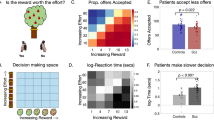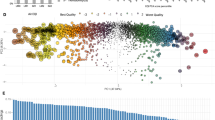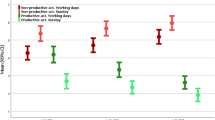Abstract
Limited negative symptoms treatment effectiveness may result from environmental resource deprivation that is a barrier for performing goal-directed, recreational, and social activities. This study showed that environmental resource deprivation in the home environment was greater for people with schizophrenia (n = 39) than 32 demographically-matched healthy controls (CN). Greater environmental resource reductions for performing goal-directed, recreational, and social activities were associated with greater negative symptoms, even after controlling for income and secondary negative symptom factors (depression, positive symptoms).
Similar content being viewed by others
Introduction
Negative symptoms—reductions in goal-directed behavior, social motivation, experience of pleasure, speech output and intonation, and emotional expressions—are a key factor underlying the poor functional outcomes observed in schizophrenia (SZ)1. Although promising treatments have been developed2, no pharmacological or psychosocial treatment yields sustained, clinically significant negative symptom reductions in SZ3.
One reason for the limited treatment advances for negative symptoms is a deficient understanding of the proximal environment’s impact on these symptoms. Although person-level factors (e.g., reward-processing, defeatist beliefs) have been the primary focus of mechanistic negative symptom research, studies have only recently begun to systematically investigate how environmental factors could be a barrier to negative symptom change. Several of these studies are grounded in the Bioecosystem Theory of Negative Symptoms4, which posits that interactive environmental systems of varying proximity to an individual are critical to the development and maintenance of negative symptoms. Initial evidence supporting this theory demonstrated that negative symptoms varied across microsystems—one’s immediate environment—such as across locations (e.g., higher at home versus in public) in SZ5. Subsequent work indicated more indirect environmental factors, including neighborhood crime and esthetics, are also linked to greater negative symptoms SZ6. Thus, emerging evidence suggests the environment plays an important role in negative symptoms.
However, less is known about how more direct environmental factors such as the availability of resources in one’s home environment are associated with negative symptoms. Examining resources that facilitate performing goal-directed, recreational, and social activities in the home environment may be especially important for people with SZ given they spend more time at home than healthy controls (CN)7. Failure to consider how a person’s most proximal environment could facilitate or hinder recreational, social, and goal-directed activities could also reduce treatment effectiveness and negative symptom change. For example, if a person lacks access to resources in the home needed for pleasurable activities, then targeting one’s internal drive, anticipation of pleasure, or related person-level factors (e.g., defeatist beliefs) may be less effective. Thus, increased understanding of the influence of direct environmental resources could provide opportunities for novel areas of intervention that may hasten treatment effectiveness.
The current study used a novel checklist built to examine environmental resource deprivation in one’s home to test an important hypothesis of the Bioecosystem Theory of Negative Symptoms: that negative symptom severity is impacted by reduced resource availability that limits performing goal-directed, recreational, and social activities. We hypothesized: (1) People with SZ would report reduced resource access within the home compared to CN, and (2) reduced access to resources at home that facilitate performing activities would be associated with greater negative symptom severity.
Methods
Participants included 39 outpatients meeting DSM-5 criteria for schizophrenia (SZ) and 32 CN. Groups did not significantly differ on age, parental education, household income, sex, or race; however, as expected, CN had significantly higher personal education (See Table 1).
Participants in both groups were recruited through online or printed advertisements. SZ were also recruited from local outpatient mental health centers. After providing informed consent online, procedures were conducted via video-call to enhance variability in environments. Participants received $20/hour for completing study procedures. Procedures were approved by the University of Georgia and the University of Nevada, Las Vegas Institutional Review Boards.
Measures
Negative symptoms
SZ and CN participants were rated on the Brief Negative Symptom Scale (BNSS;8).
Home resource deprivation checklist (HRDC)
The HRDC is a new 20-item self-report measure assessing the availability of resources in the home needed to engage in goal-directed (e.g., materials for cooking, cleaning) recreational (e.g., materials for hobbies, board games), and social activities (e.g., seating for guests). Participants are asked to respond with “yes” or “no” to indicate if they have access to the resource in each item. A total score (range 0 to 20) was calculated indexing the overall presence (or absence) of these items. The HRDC was created expressly for this study and has not been previously reported on. The supplement contains the full scale. HRDC Internal consistency was 0.81.
Analyses
A one-way ANOVA compared SZ and CN on environmental resource deprivation. Spearman correlations examined hypothesized associations between environmental resource deprivation and negative symptoms. Supplemental exploratory associations with depression and positive symptoms are in the supplement. Correlations were conducted in the full available sample given enhanced variability of scores; correlations in each group are in the supplement (see Supplementary Table 1).
Results
SZ reported significantly reduced availability of resources needed to complete goal-directed, recreational, and social activities in their home relative to CN (p = 0.008, d = –0.65; see Table 2 and Supplementary Table 2 for endorsement frequency of each item). Further, in the full sample, reduced home resource access was significantly associated with increased anhedonia, avolition, blunted affect, alogia, and global negative symptoms but not asociality (see Table 2). Of note, results were largely similar in the schizophrenia sample alone: reduced access to resources in the home was associated with greater avolition, blunted affect, and global negative symptoms (see Supplementary Table 1). The association between home resource access and negative symptoms remained highly similar in magnitude and significance even after controlling for household income or potential secondary negative symptoms factors (depression, positive symptoms; see Supplementary Table 3).
Discussion
This study bolstered support for the Bioecosystem Theory of Negative Symptoms through two key findings. First, individuals with SZ reported reduced access to resources in their home that facilitate goal-directed, recreational, and social activities. Second, these environmental resource reductions were associated with greater negative symptom severity.
The current findings suggest resource deprivation in a person’s home can influence negative symptom severity in SZ. Since many people with SZ spend more time at home than CN7, resource deprivation in the home for goal-directed, recreational, and social activities may be more impactful for SZ. Without these resources at home, inactivity and engagement in passive activities may become more pervasive, sapping energy and further reducing motivation to engage in more meaningful activities in SZ. These findings extend prior work identifying that more distal environmental factors, such as crime levels, neighborhood esthetics, and urbanicity, influence negative symptom severity (c.f., 9,10). Current findings critically identify aspects of the immediate environment—which may be more modifiable to intervention—that could be targeted to improve negative symptoms.
Of note, our findings were not fully explained by income or factors contributing to secondary negative symptoms. First, the SZ and CN groups did not significantly differ on household income levels. Second, the association between home resource deprivation and negative symptoms remained similar in magnitude and statistically significant even after controlling for household income levels. This suggests that income alone cannot explain the observed group differences or the link between home resource deprivation and negative symptoms. Similarly, the association between negative symptoms and home resource deprivation remained even after controlling for secondary negative symptom factors like depression and positive symptoms. Thus, even after controlling for potential moderating factors, the influence of home resource deprivation on negative symptoms remained.
Several limitations should be considered. First, the cross-sectional design is a limitation, and prospective longitudinal studies or more direct measures are needed to determine the direction of the association between environmental resource deprivation and negative symptoms. Despite this, results point to one’s home environment as an intervention pathway for improving negative symptoms. Although participants were recruited from diverse regions, the sample size was small. We also did not objectively assess a person’s home environment or the type of home they lived in. These findings support the initial utility of the HRDC, but larger scale psychometric evaluations are needed.
These findings may suggest that reduced resources for performing goal-directed, recreational, and social activities may maintain negative symptoms by leading to a cycle of inactivity. Without changes in access to these resources, negative symptom change may be limited. Resource deprivation may also lessen opportunities for mitigating factors such as defeatist beliefs that also contribute to negative symptoms—without opportunities to engage in pleasurable and goal-directed activities, opportunities for countering defeatist beliefs are more limited. Environmental systems-focused therapies may therefore be necessary to provide in conjunction with pharmacological and psychosocial interventions to improve negative symptoms.
Data availability
Data is available from the authors upon request.
References
Strassnig, M et al. Which levels of cognitive impairments and negative symptoms are related to functional deficits in schizophrenia?. J. Psychiatr. Res. 104, 124–129 (2018).
Cella, M et al. Psychosocial and behavioural interventions for the negative symptoms of schizophrenia: A systematic review of efficacy meta-analyses. Br. J. Psychiatry 223, 321–331 (2023).
Fusar-Poli, P et al. Treatments of negative symptoms in schizophrenia: Meta-analysis of 168 randomized placebo-controlled trials. Schizophr. Bull. 41, 892–899 (2015).
Strauss, GP. A bioecosystem theory of negative symptoms in Schizophrenia. Front. Psychiatry 12, 655471 (2021).
Luther, L, Raugh, IM, Collins, DE, Knippenberg, AR & Strauss, GP Negative symptoms in schizophrenia differ across environmental contexts in daily life. J. Psychiatr. Res. 161, 10–18 (2023).
Zhang, L, James, SH & Strauss, GP Environmental resource reductions predict greater severity of negative symptoms in schizophrenia. Schizophr. Res. 261, 94–99 (2023).
Depp, CA et al. GPS mobility as a digital biomarker of negative symptoms in schizophrenia: a case control study. npj Digit. Med. 2, 108 (2019).
Kirkpatrick, B et al. The brief negative symptom scale: Psychometric properties. Schizophr. Bull. 37, 300–305 (2011).
Van Os, J, Hanssen, M, De Graaf, R & Vollebergh, W Does the urban environment independently increase the risk for both negative and positive features of psychosis?. Soc. Psychiatry Psychiatr. Epidemiol. 37, 460–464 (2002).
Tibber, MS et al. Are socioenvironmental factors associated with psychotic symptoms in people with first-episode psychosis? A cross-sectional study of a West London clinical sample. BMJ Open 9, e030448 (2019).
Acknowledgements
This work was supported by the National Institutes of Mental Health (R21-MH122863) and the Shear Family Foundation.
Author information
Authors and Affiliations
Contributions
All authors contributed to writing and editing the manuscript. L.L. and G.P.S. led manuscript writing. L.L., Z.Z., and G.P.S. led analyses. S.H.J., L.Z., J.S., and L.A. conducted study assessments and database management. R.C., D.N.A., and G.P.S. conceptualized the study, obtained funding, and supervised the remaining co-authors on this work.
Corresponding author
Ethics declarations
Competing interests
G.P.S. is one of the original developers of the Brief Negative Symptom Scale (BNSS) and receives royalties and consultation fees from Medavante-ProPhase LLC in connection with commercial use of the BNSS and other professional activities; these fees are donated to the Brain and Behavior Research Foundation. In the past 2 years, G.P.S. has consulted for Minerva Neurosciences, Acadia, Otsuka, Boeringher-Ingelheim, and Lundbeck. All other authors have no conflicts to report.
Additional information
Publisher’s note Springer Nature remains neutral with regard to jurisdictional claims in published maps and institutional affiliations.
Supplementary information
Rights and permissions
Open Access This article is licensed under a Creative Commons Attribution-NonCommercial-NoDerivatives 4.0 International License, which permits any non-commercial use, sharing, distribution and reproduction in any medium or format, as long as you give appropriate credit to the original author(s) and the source, provide a link to the Creative Commons licence, and indicate if you modified the licensed material. You do not have permission under this licence to share adapted material derived from this article or parts of it. The images or other third party material in this article are included in the article’s Creative Commons licence, unless indicated otherwise in a credit line to the material. If material is not included in the article’s Creative Commons licence and your intended use is not permitted by statutory regulation or exceeds the permitted use, you will need to obtain permission directly from the copyright holder. To view a copy of this licence, visit http://creativecommons.org/licenses/by-nc-nd/4.0/.
About this article
Cite this article
Luther, L., Zhang, Z., James, S.H. et al. Resource deprivation in the home environment is associated with negative symptoms in outpatients with Schizophrenia. Schizophr 11, 56 (2025). https://doi.org/10.1038/s41537-025-00602-4
Received:
Accepted:
Published:
DOI: https://doi.org/10.1038/s41537-025-00602-4



